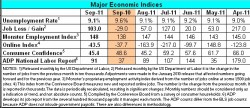 The U.S. Department of Labor issued one of its better jobs reports this morning, showing job growth in September was better than what economists expected, and revising upward its zero growth August numbers. The monthly employment report also showed improvement in hourly earnings large enough to offset the loss in August.
The U.S. Department of Labor issued one of its better jobs reports this morning, showing job growth in September was better than what economists expected, and revising upward its zero growth August numbers. The monthly employment report also showed improvement in hourly earnings large enough to offset the loss in August.
American non-farm payrolls grew by 103,000 jobs last month and by 57,000 jobs in August. The Labor Department also revised up its July jobs numbers from 85,000 to 127,000. Economists predicted September’s number would come in closer to 60,000.
Certainly a positive, the numbers weren’t enough to make a dent in the ranks of the unemployed, leaving the unemployment rate at 9.1 percent. It has hovered there since April.
A big part of the September increase in the jobs count was due to the return to work of some 45,000 Verizon employees who were on strike in August. Even so, the jobs report showed the private sector added 92,000 after accounting for the returning strikers.
Job growth was strongest in healthcare, which added 44,000 positions; construction grew by 26,000; and, retailers added 13,600. The professional and technical category increased by 48,000 jobs, fueled largely by increases in IT, management, accounting, and technical services. Staffing and related services added almost 24,000 jobs.
Government was the biggest loser as it has been for months, shedding 34,000 jobs in September, while manufacturing cut 13,000 positions.
The report showed little appetite in the private sector for aggressive hiring. Since April, the Labor Department pointed out, monthly job growth has averaged 72,000 positions. In the seven months prior, the average was 161,000.
“Given the complete lack of clarity as to what the economic outlook will be and the uncertainty about what’s going on in Europe and the political paralysis in Washington,” said Bernard Baumohl, chief economist at the Economic Outlook Group, “there is not much of an economic justification for employers to suddenly ramp up hiring.”
The indices included in the chart accompanying this post all point to tepid improvement. The Monster Employment Index is up over last year, but only by 7 percent. And it has barely budged since April.
According to the Labor Department, there are 14 million Americans out of work. A year ago, 14.7 million were out of work. Another 9.3 million are underemployed, working part-time jobs because they can’t find other work. That was a jump of 450,000 since August. A year ago in September, there were 9.5 million underemployed workers.
In addition, 2.5 million are out of work and want a job, but didn’t fit the criteria to be counted as officially unemployed. That number is virtually unchanged since September 2010.
Said John Challenger, CEO of the global outplacement firm, Challenger, Gray & Christmas, “The alternative measure of unemployment, which takes into account people who have stopped looking for work, but still want a job, as well as those working part-time because full-time work is unavailable, increased to 16.5 percent. That figure has been on the rise from a recent low of 15.8 percent in May. ”
Even the 4-cent-an-hour increase in average hourly payrolls, better than a decrease to be sure, just covers the 4-cent hourly decrease reported for August. Over the past 12 months, average hourly earnings have increased by 1.9 percent, the Labor Department reported.